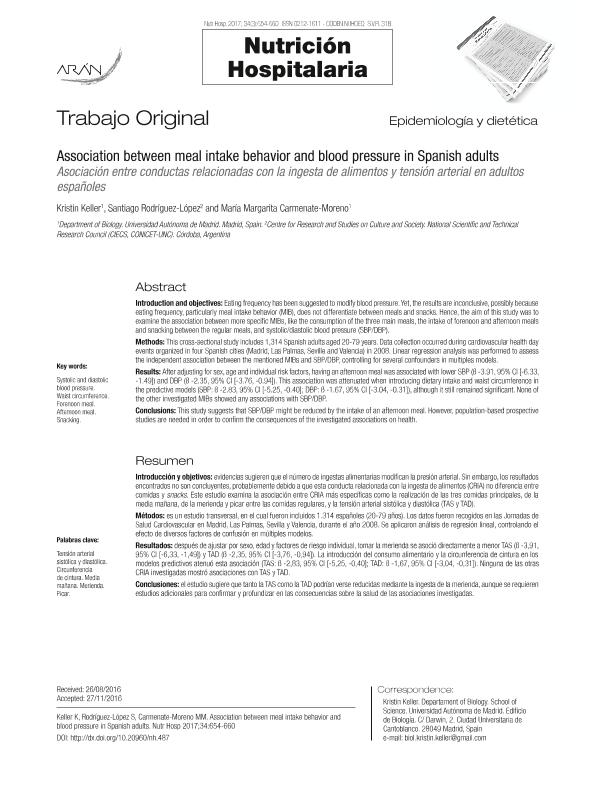Mostrar el registro sencillo del ítem
dc.contributor.author
Keller, Kristin
dc.contributor.author
Rodríguez López, Santiago

dc.contributor.author
Carmenate Moreno, María Margarita
dc.date.available
2018-12-05T17:42:09Z
dc.date.issued
2017-05
dc.identifier.citation
Keller, Kristin; Rodríguez López, Santiago; Carmenate Moreno, María Margarita; Association between meal intake behaviour and blood pressure in Spanish adults; Aula Médica Ediciones; Nutrición Hospitalaria; 34; 3; 5-2017; 654-660
dc.identifier.issn
0212-1611
dc.identifier.uri
http://hdl.handle.net/11336/65869
dc.description.abstract
Introduction and objectives: Eating frequency has been suggested to modify blood pressure. Yet, the results are inconclusive, possibly because eating frequency, particularly meal intake behavior (MIB), does not differentiate between meals and snacks. Hence, the aim of this study was to examine the association between more specifi c MIBs, like the consumption of the three main meals, the intake of forenoon and afternoon meals and snacking between the regular meals, and systolic/diastolic blood pressure (SBP/DBP). Methods: This cross-sectional study includes 1,314 Spanish adults aged 20-79 years. Data collection occurred during cardiovascular health day events organized in four Spanish cities (Madrid, Las Palmas, Seville and Valencia) in 2008. Linear regression analysis was performed to assess the independent association between the mentioned MIBs and SBP/DBP, controlling for several confounders in multiples models. Results: After adjusting for sex, age and individual risk factors, having an afternoon meal was associated with lower SBP (ß -3.91, 95% CI [-6.33, -1.49]) and DBP (ß -2.35, 95% CI [-3.76, -0.94]). This association was attenuated when introducing dietary intake and waist circumference in the predictive models (SBP: ß -2.83, 95% CI [-5.25, -0.40]; DBP: ß -1.67, 95% CI [-3.04, -0.31]), although it still remained signifi cant. None of the other investigated MIBs showed any associations with SBP/DBP. Conclusions: This study suggests that SBP/DBP might be reduced by the intake of an afternoon meal. However, population-based prospective studies are needed in order to confi rm the consequences of the investigated associations on health
dc.description.abstract
Introducción y objetivos: evidencias sugieren que el número de ingestas alimentarias modifican la presión arterial. Sin embargo, los resultados encontrados no son concluyentes, probablemente debido a que esta conducta relacionada con la ingesta de alimentos (CRIA) no diferencia entre comidas y snacks. Este estudio examina la asociación entre CRIA más específicas como la realización de las tres comidas principales, de la media mañana, de la merienda y picar entre las comidas regulares, y la tensión arterial sistólica y diastólica (TAS y TAD). Métodos: es un estudio transversal, en el cual fueron incluidos 1.314 españoles (20-79 años). Los datos fueron recogidos en las Jornadas de Salud Cardiovascular en Madrid, Las Palmas, Sevilla y Valencia, durante el año 2008. Se aplicaron análisis de regresión lineal, controlando el efecto de diversos factores de confusión en múltiples modelos. Resultados: después de ajustar por sexo, edad y factores de riesgo individual, tomar la merienda se asoció directamente a menor TAS (ß -3,91, 95% CI [-6,33, -1,49]) y TAD (ß -2,35, 95% CI [-3,76, -0,94]). La introducción del consumo alimentario y la circunferencia de cintura en los modelos predictivos atenuó esta asociación (TAS: ß -2,83, 95% CI [-5,25, -0,40]; TAD: ß -1,67, 95% CI [-3,04, -0,31]). Ninguna de las otras CRIA investigadas mostró asociaciones con TAS y TAD. Conclusiones: el estudio sugiere que tanto la TAS como la TAD podrían verse reducidas mediante la ingesta de la merienda, aunque se requieren estudios adicionales para confirmar y profundizar en las consecuencias sobre la salud de las asociaciones investigadas
dc.format
application/pdf
dc.language.iso
eng
dc.publisher
Aula Médica Ediciones

dc.rights
info:eu-repo/semantics/openAccess
dc.rights.uri
https://creativecommons.org/licenses/by-nc-nd/2.5/ar/
dc.subject
Tensión Arterial Sistólica y Diastólica
dc.subject
Circunferencia de Cintura
dc.subject
Media Mañana
dc.subject
Merienda
dc.subject
Picar
dc.subject.classification
Salud Ocupacional

dc.subject.classification
Ciencias de la Salud

dc.subject.classification
CIENCIAS MÉDICAS Y DE LA SALUD

dc.title
Association between meal intake behaviour and blood pressure in Spanish adults
dc.title
Asociación entre conductas relacionadas con la ingesta de alimentos y tensión arterial en adultos españoles
dc.type
info:eu-repo/semantics/article
dc.type
info:ar-repo/semantics/artículo
dc.type
info:eu-repo/semantics/publishedVersion
dc.date.updated
2018-10-19T15:18:35Z
dc.identifier.eissn
1699-5198
dc.journal.volume
34
dc.journal.number
3
dc.journal.pagination
654-660
dc.journal.pais
España

dc.journal.ciudad
Madrid
dc.description.fil
Fil: Keller, Kristin. Universidad Autónoma de Madrid; España
dc.description.fil
Fil: Rodríguez López, Santiago. Consejo Nacional de Investigaciones Científicas y Técnicas. Centro Científico Tecnológico Conicet - Córdoba. Centro de Investigaciones y Estudios sobre Cultura y Sociedad. Universidad Nacional de Córdoba. Centro de Investigaciones y Estudios sobre Cultura y Sociedad; Argentina
dc.description.fil
Fil: Carmenate Moreno, María Margarita. Universidad Autónoma de Madrid; España
dc.journal.title
Nutrición Hospitalaria

dc.relation.alternativeid
info:eu-repo/semantics/altIdentifier/doi/http://dx.doi.org/10.20960/nh.487
dc.relation.alternativeid
info:eu-repo/semantics/altIdentifier/url/https://revista.nutricionhospitalaria.net/index.php/nh/article/view/487
Archivos asociados
